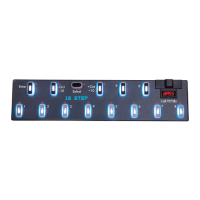4.5 Factory Presets Overview
The 12 Step comes loaded with a number of factory presets right out of the box. Many presets were
created to showcase the various options available, and others were created with interesting chords/
progressions mapped to the keys.
All presets will output over both USB and MIDI Expander (if one is connected) on MIDI Channel 1.
Note: There are a few exceptions to the channel 1 rule, namely any preset using both Voice A and Voice B.
Typically Voice B will be transmitting on MIDI channel 2.
The following presets are included with the 12 Step hardware and software:
CHrO (“Chromatic Scale”)
A simple chromatic scale. The keys are arranged starting at C2 (MIDI note 48) and go up to C3
(note 60).
bEnD (“Tilt Pitch Bend”)
The keys play a chromatic scale starting at C1 (note 36) and go up to C2 (note 48). This preset uses
the Hold note mode rather than the Normal note mode, and has key Tilt set to output pitch bend
messages.
LGtO (“Legato”)
The keys play a chromatic scale from C2 to C3 using the Legato note mode.
tOGL (“Toggle”)
The keys play a chromatic scale from C3 to C4 using the Toggle note mode.
PrES (“Pressure Volume”)
The keys play a chromatic scale from C2 to C3. Note velocity is always the maximum (127). Key
pressure outputs CC 7 messages, which are traditionally used to control volume. The expression
pedal is not mapped to anything
5OCt (“5 Octaves”)
Similar to the Chromatic Scale preset, the keys are laid out in a chromatic scale. In addition, each
key has five octaves stacked on top of one another, e.g. key 1 plays C1, C2, C3, C4, and C5; key 2
plays D1, D2, D3, D4, and D5; etc.
EPO (“Power Chords Legato”)
A “guitar-friendly” preset where each key is set to play a power chord (root, fifth, and octave). The
keys have been transposed from a C starting note to an E starting note —!e.g. key 1 plays E0, B0,
and E1; key 2 plays F#0, C#1, and F#1.
Appendix 48

